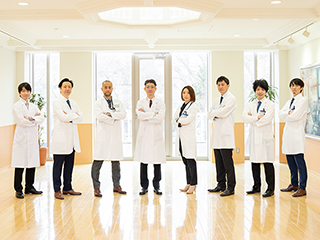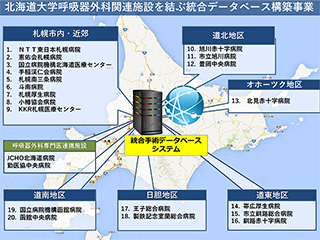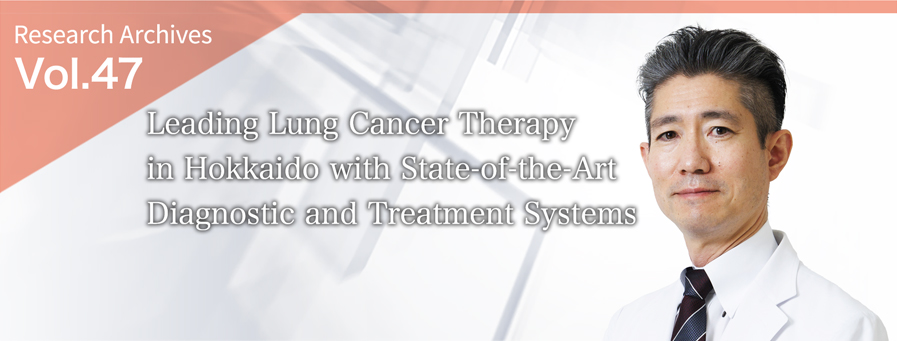
Department of Thoracic Surgery, Graduate School of Medicine, Hokkaido University
Tatsuya Kato M.D., Ph.D.Surgery
- [Academic & Professional Experience]
-
- 1997 M.D., Hokkaido University, School of Medicine"
- 2002 Research fellow in Molecular Medicine, Human Genome Center, The university of Tokyo, Theme: Lung cancer research"
- 2006 Medical Staff, Thoracic Surgery, Sapporo Minami-Sanjo Hospital, Sapporo"
- 2012 Assistant Professor, Cardiovascular and Thoracic Surgery, Hokkaido University"
- 2013 Research fellow, Toronto General Hospital, Canada"
- 2016 Clinical fellow (lung transplantation), Toronto General Hospital, Canada"
- 2017 Associate Professor, Cardiovascular and Thoracic Surgery, Clinical Training Center, Hokkaido University Hospital"
- 2022 Professor, Thoracic Surgery, Hokkaido University Hospital"
Top-level research results in tumor localization and treatment
In March 2022, the Department of Thoracic Surgery under Professor Tatsuya Kato separated from the former Department of Cardiovascular and Thoracic Surgery with its 100-year tradition of practically specializing in respiratory care since its establishment as the Second Department of Surgery in 1924. The clinical focus of medical care and clinical research is on the two pillars of minimally invasive techniques, mainly robotic and thoracoscopic surgery, and extended surgery for difficult-to-treat advanced lung cancer.
We are currently addressing three main research themes. The first is Examination of the Effectiveness of Near-Infrared Photoimmunotherapy (NIR-PIT) for Thoracic Malignant Tumors. NIR-PIT is a treatment that destroys tumor cells by binding IRDye 700Dx (IR700), a water-soluble photonic substance, to an antibody, and then irradiating the compound with near-infrared light. This research is aimed to establish NIR-PIT for thoracic malignant tumors using an antibody-IR700 conjugate with a monoclonal antibody that selectively recognizes only cancer-specific antigens [1].
For this research, Hiroshi Yamasaki, a first-year doctoral student, has been seconded to the Laboratory of Bioanalysis and Molecular Imaging (Professor Mikako Ogawa) at the Graduate School of Pharmaceutical Sciences, Hokkaido University since April 2022 to work on the targeting of various lung cancer genes using near-infrared rays. Dr. Yamasaki says, “Being able to study in the laboratory of Professor Ogawa, who plays the leading role in the field of molecular imaging, is a great experience for me.”
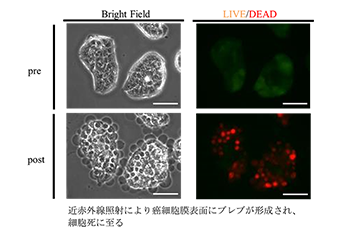
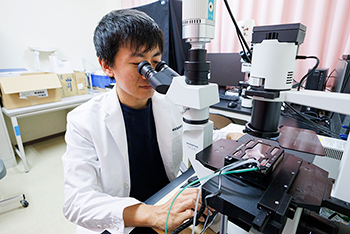
The second research theme is Basic and Clinical Research on a Novel Tumor Localization Method.
With endoscopic surgery using a thoracoscope, tumors located deep inside the lungs can actually not be seen with the eye. Indocyanine green (ICG) is therefore introduced and accumulated in these lung tumors making use of angiogenesis and blood flow, and the tumors are then identified with an ICG fluorescence spectral analysis device. Previous studies have demonstrated the ability to detect fluorescence wavelengths that are not captured by the naked eye and to possibly identify the location of tumors deep below the lung surface
[2].
Shunsuke Nomura, a fourth-year doctoral student, is involved in this research with Professor Kato and works on the development of a method to identify the site of small-sized lung cancer during surgery. Dr. Nomura says, “I’d like to conduct research to improve the prognosis and treatment outcomes of the ever-increasing number of lung cancer patients.”
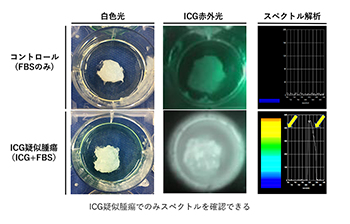
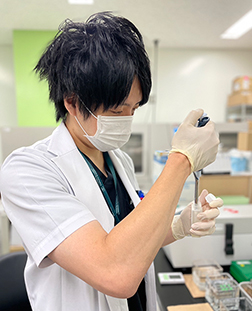
Crowdfunding for developing the lung transplant program in Hokkaido
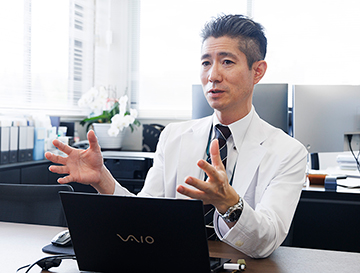
The third theme is Development of a Novel Immunosuppressive Method for Ischemia-Reperfusion Injury During Lung Transplantation. Lung transplantation is a radical treatment for end-stage respiratory failure, but chronic rejection of transplanted lungs is the biggest obstacle to long-term survival, and an effective treatment has not been established yet. An important strategy for stable long-term results after lung transplantation is to establish new immunosuppressive methods that do not induce chronic rejection. Primary graft dysfunction (PGD) is caused by the innate immune response, including a strong inflammatory response and ischemia-reperfusion injury of the transplanted lung in the early post-transplant period, which does not only significantly affect the short-term outcome of transplantation, but also strongly affects the subsequent acquired immune response that causes chronic rejection. This research is aimed to apply a novel immunosuppressive method of treating PGD using a novel erythropoietin analogue (ARA 290: cibinetide) that has been shown to have anti-inflammatory and cytoprotective effects during cell transplantation, to lung transplantation, leading to its clinical application.
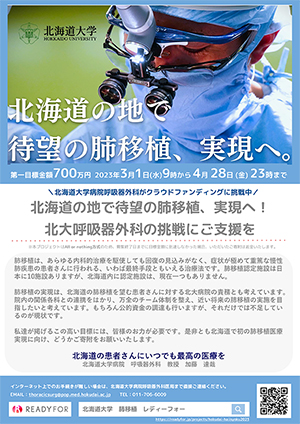
On March 1, 2023, our department started a crowdfunding campaign to realize lung transplantation in Hokkaido. Currently, there are no certified facilities in Hokkaido where lung transplantation can be performed, and patients who wish to have a lung transplant have no choice but to undergo transplant surgery outside Hokkaido, though various issues such as transportation to a transplant facility and costs remain.
The crowdfunding campaign has raised a total amount of more than 17 million yen, far exceeding the target 7 million yen, within about two months since its launch. Many donations were collected from patients, their families, and medical professionals. These funds will be used to prepare for facility accreditation and human resource development, with plans to support studies at existing accredited facilities and abroad.
Professor Kato say, “In addition to physicians, a very large number of nurses, technicians, and other staff members are involved in transplant surgery, and each of them must be highly skilled. We are in the final stages of applying for facility accreditation, and there is an urgent need to train personnel who will be responsible for our lung transplantation program five to ten years from now.”
(Interviewed in August 2023)
Working together to develop lung cancer treatment in Hokkaido
Our department has five faculty members including the professor and four medical staff members, and there is an atmosphere of free discussion. Taking what is good, adopting it as a team, and raising the level of the whole. That is the motto of this department. As part of the 10-year integrated education program, a system is also being created to ensure a research period during which graduate students can concentrate on experiments.
In an effort to change the stigma that Hokkaido has the worst lung cancer mortality rate in Japan, our department and 21 related facilities in Hokkaido have joined forces in a project to create a database to share data on the prognosis and surgical pathology of lung cancer patients throughout the prefecture. As the central hospital for lung cancer treatment in Hokkaido, our department promote screening activities for early detection of lung cancer before symptoms appear in cooperation with the Cancer Control Section of the Regional Health Division at the Hokkaido Government. Our department has also just started a study to validate the effectiveness of next-generation cancer tests using urine microRNA in cooperation with a company.
